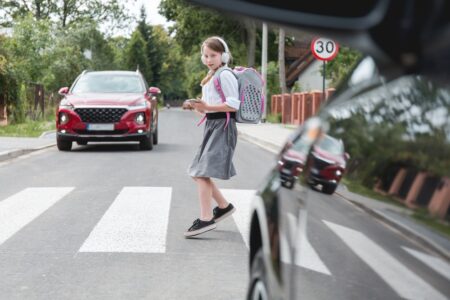When pedestrian accidents occur, they can lead to devastating injuries. Albany has several areas where pedestrian accidents may prove more likely, including areas like Clinton Avenue, where few pedestrian crossing signals exist, or Madison Avenue, where heavy traffic may contribute to an increased risk of pedestrian accidents.
A study conducted by Insurify ranked Albany as the 12th most dangerous city for pedestrians in the United States. In Albany, around 25.7 drivers per 10,000 received citations for failure to yield to a pedestrian. Consult with a New York pedestrian accident attorney, if you are facing a pedestrian accident situation.
High-risk Intersections In Albany
 Albany has a number of high-risk intersections where accidents do occur more often.
Albany has a number of high-risk intersections where accidents do occur more often.
They may include some of the most dangerous intersections for pedestrians in New York, as identified by the New York City Pedestrian Safety Study and Action Plan.
- Washington Avenue/Central Avenue and Lark Street
- Central Avenue and Robin Street
- Henry Johnson Boulevard and Clinton Avenue
- Central and North Lake LaneThese intersections may generally have a higher risk of seeing pedestrian injuries and fatalities.
Where Do Pedestrian Accidents Occur Most Often?
Several factors can contribute to the risk of pedestrian accidents. Understanding those risks may increase the odds that pedestrians can stay safe from accidents.
Outside of Intersections
Only around 23.6 percent of pedestrian accidents occur at intersections. Intersections generally have clear markings and crossing signs, which indicate when pedestrians can safely cross through an intersection. They may also warn drivers, who know they need to slow down and watch out for pedestrians. In areas without intersections, drivers may naturally travel faster, leading to more serious pedestrian injuries when an accident occurs.
Pedestrians who regularly walk or jog on the road may find themselves in additional danger, especially during high-traffic times of the day. Some drivers may not take the visual profile presented by a pedestrian into account when driving, which means that they may not recognize the presence of a pedestrian on the road until it grows too late. Reflective gear may help make pedestrians more visible but may not entirely reduce accident risk.
Urban Areas
Highly-populated urban areas have, in general, a much higher risk of pedestrian accidents. In urban areas, traffic tends to flow more heavily, and pedestrians may have fewer options for crossing safely without waiting a substantial period for traffic to pass.
Furthermore, in urban areas, people may simply spend more time walking. Dense urban areas often have more things within walking distance and better public transportation systems, so people may choose to walk between locations. In rural areas, on the other hand, different locations tend to sit further apart, and people may not have adequate time to reach their destinations while walking.
As a result, they may choose to travel via car instead of on foot, decreasing overall pedestrian traffic and the risk of those types of accidents.
Parking Lots
A large percentage of car accidents, in general, occur in parking lots. Unlike roads, parking lots may not have clear designations of exactly where vehicles need to travel and when. Many drivers engage in reckless behavior in parking lots, zipping into parking spaces and trying to get around pedestrians. Drivers may not exercise much patience in those parking lots and other parking areas, like parking garages, despite acknowledging the high number of pedestrians who need to travel through that area.
Drivers may also fail to pay adequate attention to pedestrians in parking lots due to distractions from external and internal sources. They may focus on finding a parking space or on planning to get to their destination as quickly as possible, which means they may end up causing an accident because they never notice the presence of a pedestrian around them.
Furthermore, drivers may fail to adequately check around and behind them before backing out of a parking space. Vehicles with large blind spots can pose additional risks.
Trail Crossings
Albany has a number of places where people can easily get out in nature and enjoy a long walk or run. Cunningham Park, for example, offers gorgeous walking trails. Unfortunately, those trails also cross the road in several locations. Pedestrians may not fully realize that the trail they have chosen to use crosses the road. Furthermore, drivers down those roads may not pay attention to trail crossings the way they should, especially if those trails do not include clearly-marked signs and signals for pedestrian crossing.
Shared trails can also pose the potential for pedestrian accidents with other vehicles. For example, many trails are used by cyclists or skateboarders, who may travel at a much higher speed than the average pedestrian. Those riders may also bear liability when their dangerous or reckless actions cause injury to a pedestrian on the trails. In high-traffic areas, cyclists and skateboarders may have a more challenging time avoiding collisions with pedestrians.
Likewise, heavy foot traffic may increase the noise level in the area, making it more likely that pedestrians will fail to hear an approaching wheeled conveyance or even a warning.
Intersections Without Clear Pedestrian Crossings
When pedestrians travel through the streets of Albany, they need to know where they can safely walk. Clearly-marked pedestrian crossings can let pedestrians know where they should cross and provide motorists with a warning that pedestrians may need to use that area.
Marked signals, including clear light changes to let pedestrians know they can safely cross, can also improve pedestrian safety. Unfortunately, many of the intersections throughout Albany may not have those warnings. At intersections that lack pedestrian crossing signals, pedestrians may cross when it feels convenient for them, raising the risk of an accident.
Intersections and Streets With Poor Lighting
According to the NSC, almost 76 percent of pedestrian accidents occur at night, in the dark. Less than 20 percent occur in full daylight, with the others occurring during dawn or dusk. Poor lighting can make it much more difficult for drivers to see pedestrians around them. In some cases, particularly when pedestrians dress in dark clothing, drivers may not notice their presence until they end up nearly on top of them.
Areas with poor lighting can also present other visual challenges, including making it very difficult for drivers to see how traffic should flow through an intersection or making it hard for drivers and pedestrians to safely navigate the area.
Other Factors That May Increase the Risk of Pedestrian Accidents
While some pedestrian accidents may occur due to the location, others may occur due to other factors, including driver behaviors.
Clear Weather
Around 88 percent of pedestrian fatalities occur during clear weather conditions. Dangerous weather conditions, including snow and ice, can increase the risk of some types of collisions. During hazardous weather, however, many people will choose, in general, to spend less time out on the road. They might decide to use public transportation, drive, or simply avoid getting out. As a result of lower pedestrian traffic, fewer accidents may occur.
Furthermore, drivers often exercise more caution in dangerous weather conditions. They may slow down, turn on their lights, and pay more attention to the conditions around them than they would in clearer weather conditions. As a result, drivers may see pedestrians earlier and have more time to react in the event of an accident.
While clear weather conditions may make it easier for drivers to navigate, the extra precautions required to deal with dangerous weather, including the snow common in the Albany area, may decrease the risk of pedestrian accidents and injuries.
Pedestrian Age
According to the CDC, pedestrian accidents occur more commonly among older members of the population, over the age of 65, and younger members, under the age of 15. While children may engage in more reckless behavior that can prove difficult for drivers to predict, older adults may have visibility challenges or mobility issues that can make it more difficult for them to get through an intersection safely. Drivers in Albany may need to exercise particular caution in school zones or areas frequented by the elderly, where accident risk may increase.
Pedestrian age may also impact the severity of accidents. For example, many elderly people prove more susceptible to serious injury in the event of an accident, even if they take all necessary precautions. A low-speed collision can cause much more devastating injury to an older individual than a younger one. Younger individuals may also face a higher risk of fatal or devastating injury related to a pedestrian accident due in part to their smaller size.
Intoxication
Driver intoxication causes challenges that may increase the risk of a devastating collision. An intoxicated driver may struggle with tunnel vision, meaning he might never see a pedestrian stepping into a crosswalk. Intoxicated drivers often struggle with poor decision-making and may have difficulty correctly judging the behavior of others around them, making them more likely to cause a collision.
Intoxicated drivers may also have slowed reflexes that can make it more difficult to avoid a collision when they notice the presence of a pedestrian late, as they get very close to the person on the road. An intoxicated driver may try to slam on his brakes but may not have adequate time to slow down or get out of the way to avoid an accident.
Because of those slowed reflexes, intoxicated drivers may also cause more devastating injuries to pedestrians injured in an accident since they do not have as much time to turn away or try to reduce the impact.
Driver Speed
At a high rate of speed, drivers may have difficulty slowing down or coming to a stop around pedestrian areas. That may mean that drivers have a greater likelihood of causing a collision with a pedestrian. At high rates of speed, drivers would need to see pedestrians earlier to avoid an accident.
Drivers who speed may not pay enough attention to the possibility of pedestrian traffic, raising the odds that they will cause an accident. Driver speed may also impact the collision’s severity: drivers may cause even more serious injury to pedestrians at high rates of speed.
Day of the Week
According to the NSC, pedestrian accidents occur more frequently at night on Fridays and Saturdays compared to the rest of the week. Daytime accidents, on the other hand, happen more frequently on weekdays. The day of the week may determine how much pedestrian traffic passes through the area.
For example, many people will spend more time on the streets of Albany after dark on the weekends, when they may have more time to go out and enjoy leisure activities. During the week, on the other hand, many of Albany’s streets may see more pedestrian traffic during the workday.
A Lawyer Can Help After a Pedestrian Accident
When a pedestrian accident occurs, the victim may have the right to pursue compensation for any injuries sustained in the crash. However, all too often, pedestrian accident victims struggle to get the full compensation they deserve for those injuries.

Insurance companies may try to insist that the pedestrian did not really have such high medical expenses related to the accident or that the pedestrian contributed to the accident, both of which can reduce the compensation the accident victim can ultimately take home as part of a claim.By working with a lawyer, you can get a much better idea of the compensation you deserve after a pedestrian accident and how to move forward with your claim, including how you can establish evidence of liability. Contact a personal injury lawyer in New York as soon after your accident as possible to start the claim process.
